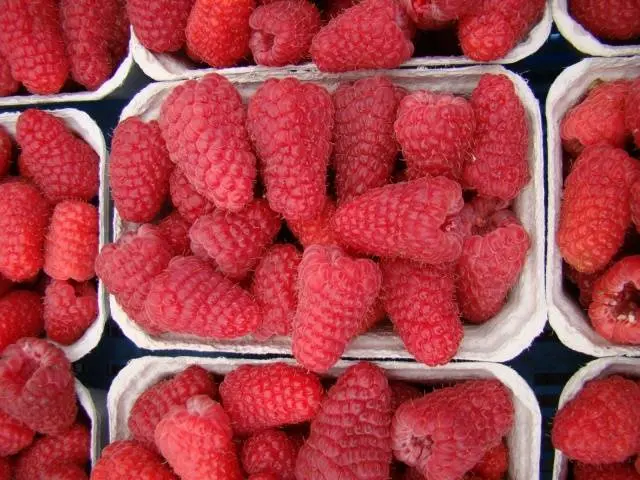Contents
Raspberry Moscow giant has become one of the novelties among large-fruited raspberry varieties of recent years, but, despite its very attractive characteristics, the appearance of this variety is covered with a touch of uncertainty. Indeed, the Moscow giant has not yet been entered into the State Register of Our Country. And in the catalogs of raspberry varieties of famous breeders working in the Moscow region, he is also not mentioned.
Nevertheless, the Moscow giant raspberry is actively distributed and advertised by several large garden centers, such as Garden and Victoria. In this article you can find a description of the variety, as well as its photo and some reviews of gardeners. But how reliable these data are, you can only check for yourself by planting this raspberry variety in your garden.

Variety description
It should be noted that, in addition to the Moscow giant raspberry variety, it is often possible to find a description of the Moscow giant variety in various sources.
Perhaps they are the same variety, the name of which has been modified for promotional purposes.
The name of the variety speaks for itself in many ways. In plants of this variety, all parts are gigantic in size – from shoots and leaves to flowers and berries.
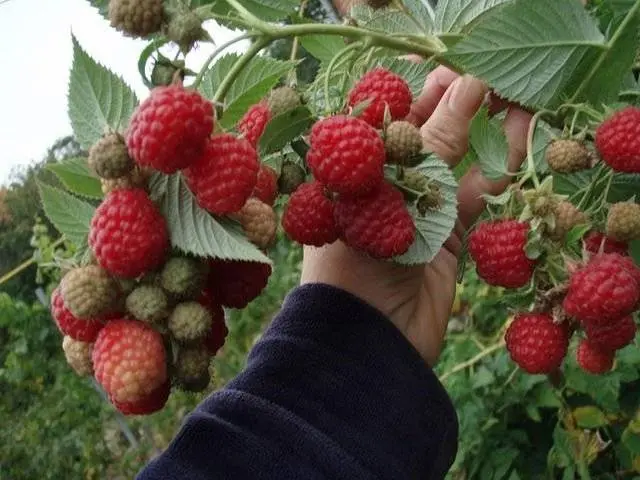
It is clear that the stems are characterized by great growth force. In height, they can reach two meters or even more. In general, the bushes tend to build up a large amount of green mass, so it makes sense to be very careful with the Moscow Giant raspberry dressing. Otherwise, instead of many large-sized berries, you can only get powerfully overgrown green bushes.
Nitrogen fertilizers can only be applied in early spring, and then it is better to switch to phosphorus-potassium supplements with the obligatory addition of trace elements.
The leaves are unusually large in size and juicy bright green color.
The shoot-forming ability is in the medium range – about 10 new shoots are formed every season, some of which can be used for propagation. Root shoots are formed, but also on a medium scale – up to 4-5 per bush.
In terms of ripening, raspberries of the Moscow giant can be attributed to early ripening. It begins to bloom already in May-June, and the first fruits appear by the beginning of July. An important feature of the raspberry of this variety is its tendency to remontant. That is, in conditions of an abundance of sunny days, it is able to give a second crop at the end of summer – in the fall on young shoots of the first year.
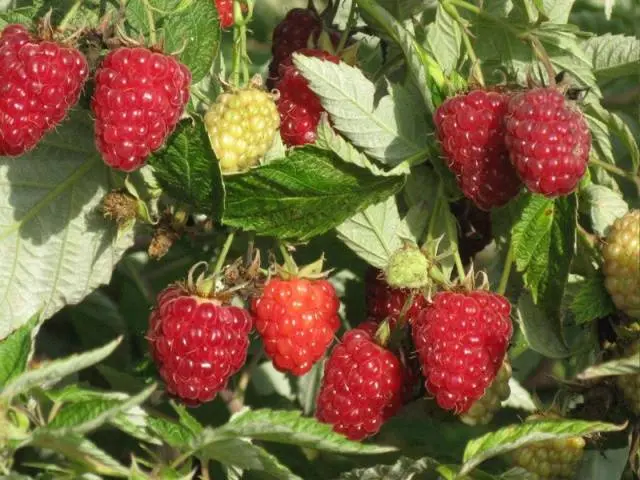
Their main difference from real remontant varieties is the fact that berries appear, as a rule, only in the very upper part of the shoots, and not along their entire length, as in remontant raspberries. In addition, the appearance of the second crop is largely determined by warm and sunny weather conditions during the spring and summer. A guaranteed second harvest on raspberries of this variety can be expected only in the southern regions of Our Country.
Nevertheless, under such favorable conditions, the yield of the Moscow Giant raspberry can reach a total of up to 10-12 kg per bush per season. But the average yields of this variety are also impressive – even when grown in the conditions of Central Our Country, about 6-8 kg of raspberries are obtained from one bush.
It is also expected that this variety has above average resistance to major pests and diseases and high frost resistance. There are some doubts about the last point, since large-fruited raspberry varieties, if they can endure frosts down to -25 ° -30 ° C, then they do not tolerate periods of thaws well and often grow out with significant temperature changes in winter. True, judging by the reviews, the Moscow Giant raspberry bushes have good resilience and are able to renew from the roots even after the lower part of the shoots freezes or rots.
Characteristics of berries
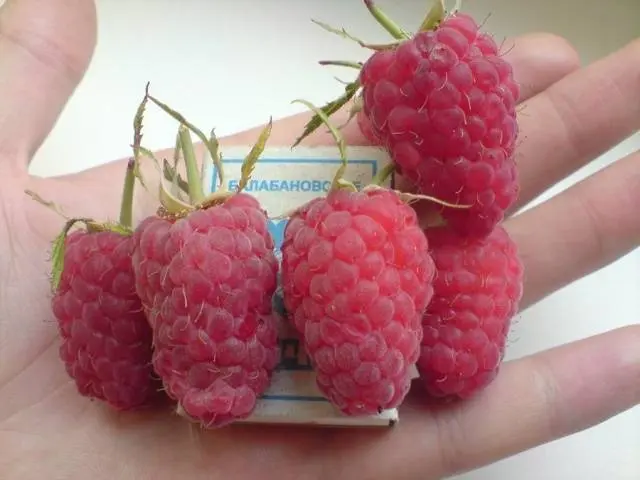
The name of this raspberry variety refers primarily to the berries. They can indeed be gigantic in size, the size of a matchbox or more. The mass of one berry is on average 10-15 grams, and the very first berries easily reach 20-25 grams.
- The pulp of the fruits of raspberry Moscow giant is quite dense, but at the same time very juicy;
- The berries have a very beautiful shiny surface;
- The drupes are firmly linked to each other;
- The shape of the berries is conical and occurs from moderately to strongly elongated;
- The color of the fruit is bright, red-crimson, when fully ripe – dark;
- The taste is sweet, typically raspberry, with a barely pronounced sourness;
- The seeds are so small that they are not felt at all when eaten;
- The berries of this raspberry variety, due to their density, have good transportable properties and are well stored, therefore they are quite suitable for growing for sale;
- The use of berries is universal, they retain their shape after freezing, they make delicious fruit drinks, compotes, jellies and jams;

- Fruits can be stored up to 3-5 days at room temperature and up to 10 days in the refrigerator.
Planting and care
Despite the high yields and the gigantic size of the berries, caring for the Moscow Giant raspberry is no more difficult than for any other large-fruited raspberry varieties.
From the moment of planting, it is necessary to make sure that the raspberry bushes are comfortable and cozy in the place chosen for them.
The place should be not only bright, but also sunny, but at the same time protected from strong winds. Any raspberry will like to grow on supports or trellises, as this increases the access of air and light to all parts of the plants. And, of course, regular watering is a necessary element of caring for raspberries of this variety. One bush will require about 10-15 liters of water.
Since raspberry bushes spend a lot of energy on the return of a large crop, they also require regular top dressing throughout the warm season. But by the beginning of autumn, it is advisable to stop them so that the shoots have time to mature well and prepare for the winter.
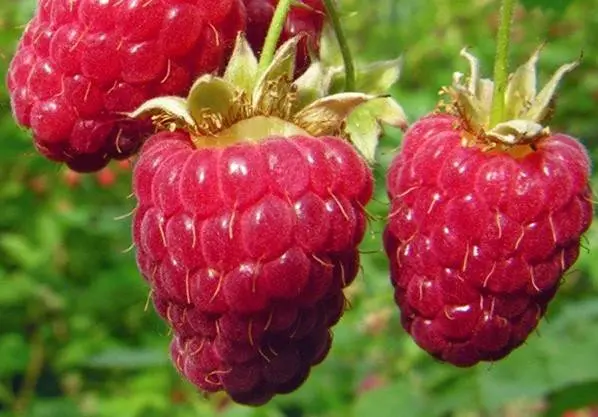
Pruning raspberries The Moscow giant differs from pruning traditional raspberry varieties and remontant ones. If the young shoots of the first year managed to bear fruit at their top in the current season, then before the onset of stable frosts, the upper part of the shoot is removed. This is done even if unripe berries are preserved at the top. The following year, fruits form on the remaining lower part of the shoots, and only after the final harvest is the entire shoot removed completely.
It is not recommended to prune these raspberries as remontant varieties completely before autumn, because in this case you will lose part of the crop that would have ripened on these shoots next year.
But in regions with harsh climatic conditions, it is possible to grow the Moscow giant as an ordinary two-year-old raspberry, cutting out only two-year-old shoots that bear fruit in the fall and not touching the one-year growth at all.
Reviews of gardeners
Raspberry variety Moscow giant appeared quite recently and therefore there are not so many reviews on it. In addition, gardeners often confuse it with other varieties, such as the Yellow Giant, Moscow Giant, Hercules and others.
Conclusion
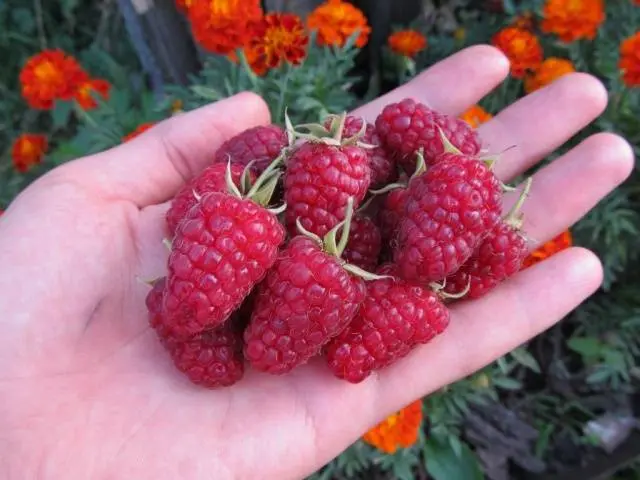
Raspberry Moscow giant is one of the most large-fruited and productive varieties. But in order for it to be able to show all its capabilities, it is necessary to find the right approach to it.










